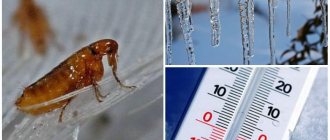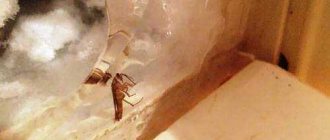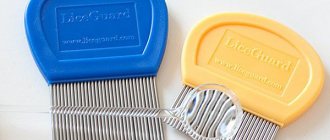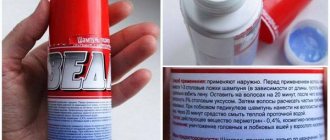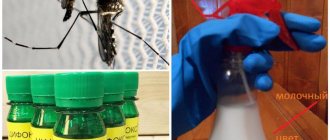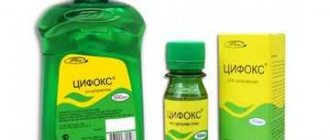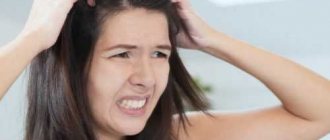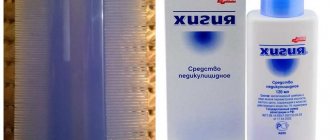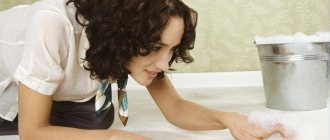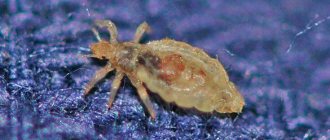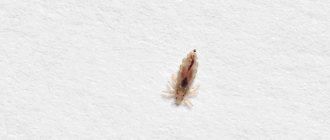To effectively combat head lice, you need to know at what temperature lice die. Violation of comfortable conditions negatively affects adults and their larvae. By changing the temperature, you can kill lice without resorting to chemicals.
Temperature changes negatively affect lice and nits.
Ideal living conditions for lice
Lice are perfectly adapted to living among human hair. The optimal ambient temperature range for insects is +20…+38°C. Under such conditions, parasites actively feed and reproduce. When the temperature drops below +20°C, insects begin to feel discomfort. They become more lethargic and eat less.
When the temperature rises to +40°C, lice move to the ends of human hair, and their reproduction stops.
What happens to insects
The activity of insects directly depends on the ambient temperature. If lice find themselves in unfavorable conditions, their life activity is inhibited. The larvae inside the females do not die. When the temperature normalizes, the development of the offspring continues.
Minor changes in conditions cannot harm the eggs. The nit is covered with a durable shell that protects it from temperature fluctuations. It can survive heating even up to +50°C. Nits are more sensitive to frost: their development stops when it gets colder.
Temperature harmful to nits.
At what temperature do lice and nits die?
A temperature drop below -20°C leads to the death of adult insects, nymphs and eggs. Compared to other insects, lice are characterized by increased resistance and vitality. Nymphs, eggs and adult lice die instantly when heated to +60°C and above.
Exposure to cold
A decrease in temperature has the following effects on the vital activity of parasites:
- -5°C – adult individuals stop feeding and reproducing, nits’ development stops;
- -15°C – adult insects die, but the life of nits continues;
- -20°C – insect eggs die.
Exposure time is important. At a temperature of -17°C, it will take more than 2 hours for insects to die. If the thermometer shows -20°C, lice and nits will die in about 40-45 minutes.
Low temperatures cause the parasite to stop developing and die.
Exposure to heat
Heat has a detrimental effect on insects:
- at +40…+45°С lice stop reproducing;
- at +40...+60°C adult parasites die, but the vital activity of the larvae does not stop;
- above +60°C insects die at all stages of development.
Can nits survive without humans?
Lice eggs are called nits. During her life, the female lays up to 120 eggs. They are small, round, white and attached to the base of the hair with an adhesive substance. The larva matures in them within a week. The nit has a fairly strong shell that protects the larva from mechanical and partly from chemical damage. When unfavorable conditions occur, nits, or more precisely, the larvae in them, are capable of falling into a state of suspended animation. This is a conditional deep sleep with “freezing” of all body functions. The larva stops its development, but remains alive. Some nits spend up to two weeks in a state of suspended animation. If after this they find themselves in normal conditions, they will continue their development and turn into adults, and then into adult lice.
Effect of temperature on reproduction
Parasites are able to reproduce in a relatively narrow temperature range.
With a slight deviation from optimal values, reproductive function becomes unstable:
- at +40…+45°С – females stop laying eggs;
- at +45...+50°C – all adult insects die within 2-3 hours;
- at +50...+55°C – adult lice die, unable to withstand this temperature, while nits are more stable and can continue to live for some time;
- above +60°C – the entire insect population dies, including adults and their eggs.
The life cycle of lice under favorable conditions is 33-40 days. Insects begin to reproduce on the 15th day. Females lay eggs, which are commonly called nits. They are drop-shaped formations of whitish and yellow color, oblong in shape.
Diagram of the life cycle of a head louse.
The female lays eggs at the roots of the hairline, attaching them with an adhesive liquid produced by special glands. This allows you to securely fasten the larvae. It is impossible to remove them by scratching. The ripening period for nits depends on environmental conditions and is 5-12 days. An insect nymph emerges from the egg, which cannot leave offspring until it reaches sexual maturity, but actively feeds along with adult lice.
When the temperature drops by 3-5 degrees, insect metabolism slows down. At +20 °C and below, the nits’ biological defense mechanism is activated. The development of larvae into adults is suspended until suitable conditions arise.
How to kill nits in one go at home?
It’s definitely not possible to kill nits at home in one go. To treat head lice, it is necessary to take an integrated approach. Traditional methods such as suffocating harmful insects using oils and petroleum jelly must be repeated for several days. It is also recommended to use a special comb that helps comb out nits. It is possible to use special preparations, but their results are also effective with repeated use.
Can you kill lice with hair dye?
There are many articles that advise getting rid of lice at home by dyeing your hair. Many people consider this method of combating head lice to be effective because they cannot find either lice or eggs on the child’s head, but in fact the parasites have simply become colored along with the hair.
Can you use a hair straightener to kill nits?
By heating your hair with a straightening iron, you can actually get rid of nits. But this will not solve the problem, since adult lice will still remain and lay new eggs.
Can a hairdryer kill lice?
A standard home hair dryer will kill up to 96.7% of eggs when used correctly. To achieve a positive result, blow drying must be done repeatedly (within 7 days, as eggs take 7 to 10 days to develop) until the natural life cycle of the louse (about 4 weeks). Remember that it is not enough to kill the nits; they need to be combed out with a comb.
Can you kill nits with vinegar?
Vinegar is a common folk remedy against head lice, but some people mistakenly believe that it can kill adults and their nits. In fact, vinegar will not kill lice directly because it is not toxic to them. However, this can help get rid of nits, which will prevent new ones from appearing. Acetic acid destroys the outer shell that envelops the egg, after which the nits cannot stick to the hair.
Is it possible to kill lice with hydrogen peroxide?
You can get rid of head parasites using hydrogen peroxide. To do this, mix one part peroxide with two parts water. Apply this mixture to your hair and leave for several hours. Afterwards, wash your hair with shampoo containing coconut oil. The procedure must be repeated until the parasites disappear. Be sure to wash all your bedding with hydrogen peroxide to avoid re-infecting yourself. And don’t forget about combing out parasites after baiting them with peroxide.
Table: dangerous temperature for lice
| Temperature | Effect |
| -20°С | Instant death of the entire population: adult insects, nits, eggs. |
| -15…-20°С | Death of insects at all stages of development occurs within a few minutes. |
| -5…-15°С | Adults die. Nits survive. |
| 0…+5°С | The parasites stop feeding. Metabolism stops. |
| +40…+45°С | Reproduction stops. |
| +45…+50°С | Lice die within 0.5-3 hours. |
| +50…+55°С | Adult parasites die within a few minutes. |
| +55…+60°С | The nymphs die instantly. |
| +60°С | Lice and nits die instantly. |
Boiling is our friend
It is best to boil the laundry for 15 minutes. in a 2% solution of sodium carbonate, such treatment against lice will be very effective. Hang your things on the balcony and let direct sunlight disinfect the items throughout the week. After the required period of time, iron all the clothes (with steam), without missing a single wrinkle - this will prevent the possibility of parasites. After all, the temperature of the steam is much higher than the death temperature of the nit. You should also disinfect all hygiene items: immerse all combs and combs in boiling water for a couple of minutes, as lice can hide between the bristles.
Temperature control methods
To kill parasites, methods involving heating and greatly reducing the temperature are used. Depending on the circumstances, you can use the most suitable option.
Hairdryer
A hair dryer can be used to loosen parasites. First you need to wash your hair with hot water, then select the maximum heating of the air stream that a person can tolerate. It is recommended to use a diffuser-shaped nozzle.
To kill lice at home, use a hair dryer.
The hairdryer is brought to the skin and heat treatment begins for 8-10 minutes. To prevent the device from overheating, take a short break. After some time, the procedure must be repeated 2 more times.
After heating with a hairdryer, lice do not die, but become inactive. They do not adhere well to the hair and can be easily combed out with a brush or a special comb. Parasite eggs hatch in 7-10 days. To achieve optimal results, treatment should be carried out at least once a week.
Iron
To destroy parasites, it is convenient to use an iron or curling iron. Thanks to the high temperature, you can get rid of adult insects and their larvae.
The procedure should be carried out as follows:
- Wash your hair thoroughly with shampoo.
- Distribute hair into small strands.
- Treat your curls with heat-protective agents to reduce the negative effect of strong heat.
- Gradually process each strand from the roots to the ends of the curls, slowly running the surface of the iron along the entire length.
- After the procedure, comb your hair thoroughly with a special comb and wash your hair again.
The anti-lice iron also affects young individuals and parasite eggs.
The duration of contact of the surface of the iron with the hair should not exceed 2 seconds. Otherwise, exposure to high temperatures may harm the structure of the curls.
Steamer
You can process things using a household steam generator. The method is effective for killing body lice. Hot steam can destroy insects at all stages of development. The procedure is recommended to be carried out for 20-30 minutes. After processing items of clothing and bedding, you need to clean them of dead parasites with a brush, then wash them.
Bath
The bath is a traditional way to combat head lice. It should be remembered that parasite eggs can withstand heating up to +60°C. Adult insects and nits can be destroyed in a room heated to +80°C. In this case, you should not only steam, but also actively water your hair with hot water.
After the procedure, it is necessary to remove dead parasites with a comb. In 3 sessions you can completely get rid of lice.
To treat lice, you can go to the bathhouse.
Cold
Frost can also cause the death of insects. To combat body lice, you need to hang out and leave underwear and clothing outside for 48 hours. Under such conditions, adults, nymphs and eggs die.
After keeping the clothes in the cold, you should use an iron or steam generator to treat the internal seams, where parasites like to settle, then wash the items thoroughly.
If it's warm outside, you can use another method. Infected items of clothing should be packed in a plastic bag and placed in the freezer for 3-4 hours, then take out the items, remove dead insects with a brush, wash them and iron them.
Iron
You can kill body lice using an iron. Items must be ironed carefully, paying special attention to the lining and inner seams of the garment. It is necessary to use heating of at least +60°C. At temperatures above this value, adult parasites and eggs die instantly.
Ironing is an effective remedy for lice.
Specialized insecticides
These substances are used in most modern shampoos, gels and balms. As a rule, they paralyze the nervous system of lice and lead to their death within a few minutes after applying the product to the hair.
As such toxic components in the composition of pediculicidal agents, various pyrethroids are mainly used - Cypermethrin, Deltamethrin and some of their analogs. They are contained, for example, in lice preparations such as Medifox, NOC, Bubil, etc.
A special type of silicone called Dimethicone is also effective against lice. It works in a slightly different way: by effectively flowing into the respiratory tract of insects, Dimethicone leads to the suffocation of parasites. The substance is part of the Nuda product.
Products based on modern insecticides are very effective against lice and are relatively safe to use - they rarely cause allergies and do not lead to intoxication. They are most often used in the fight against lice in children.
Advantages and disadvantages
Compared to the use of chemicals, the temperature exposure method has such advantages as:
- accessibility and low cost - no need to purchase special reagents, processing is carried out using household devices;
- the ability to use the described methods without prior preparation;
- environmental friendliness and safety - no toxic drugs are used that could fall into the hands of children or harm pets;
- high efficiency, allowing to completely exterminate parasites.
The temperature exposure method also has some disadvantages that must be taken into account:
- high temperature can lead to burns of the skin on the head;
- the procedure must be repeated several times to consolidate the result;
- The hair structure deteriorates.
Based on the combination of characteristics, treatment of pediculosis with temperature exposure is one of the best options to get rid of parasites.
Traditional methods
Protection against lice using traditional methods is a safe option that does not require significant material costs. Many insects are sensitive to strong and pungent odors. Strong-smelling substances can help prevent lice from appearing or make them more vulnerable. To protect yourself and your loved ones from parasites, you need to know what smells lice are afraid of.
Lice don't like smells:
- grated garlic;
- tea tree;
- geraniums;
- rosemary;
- lavender;
- eucalyptus;
- menthol;
- tar.
Common Mistakes
When fighting parasites, it is important to avoid mistakes that can lead to unpleasant consequences:
- use excessively high temperatures, which can damage the hair structure;
- store the clothes of the infected person together with the clothes of other family members;
- Carelessly use a curling iron or straightener (this can lead to thermal burns to the scalp).
Washing your hair cannot get rid of parasites, because... The temperature of the water that a person can tolerate is lower than the temperature at which insects die.
How long do lice live outside the human head?
Lice are species-specific parasites that live only on the human body and feed only on its blood. This means that they do not parasitize other species, such as dogs or cats. That is, it is impossible to catch lice from pets; they are transmitted only from person to person. Moreover, you can become infected without direct contact with the carrier. This happens because lice outside a person's head can live for a while. They can live without a person and move outside of his body. However, without food they will die, so their time away from a food source is limited. Let's look at how long lice live outside the human body below.
Content:
Prevention of head lice
Symptoms of lice infestation are itching, skin pigmentation due to the inflammatory process, and sometimes the formation of tangles (tangled hair that is glued together by parasite secretions).
The main source of head lice is an infected person. Causes of the disease: neglect of personal hygiene, contact with a parasite carrier or its belongings.
Prevention of pediculosis involves compliance with the following measures:
- To avoid infection with pubic lice, avoid casual sexual intercourse. Use only your own combs and hair clips.
- Do not allow strangers to wear or try on hats.
- Wash and iron linens and clothes regularly.
- Take precautions in swimming pools, bathhouses, and public baths to reduce the risk of pubic lice infestation;
- Swim and wash your hair regularly.
If there is an increased likelihood of infection, it is additionally necessary to:
- periodically inspect your hair for the presence of parasites;
- use odorless repellents;
- wash your hair using special shampoos.
Prevention measures against lice.
Are lice and nits afraid of water? Can they breathe underwater?
The main route of transmission of lice is contact, i.e. transmission of the pathogen occurs through touching, hugging, sharing contaminated objects, including swimming together in a pool, visiting a bathhouse with a sick person. Disease carriers can spend two days under water at + 15 – 17° without harm to themselves, so they are not afraid of water.
Additional questions and answers
Before the procedure for eliminating parasites, it is useful to study the answers to frequently asked questions.
How is human body temperature related to lice reproduction?
The optimal temperature for the life of lice is +35…+37°C. Under such conditions, parasites actively reproduce and feed. If a person gets sick and his body temperature rises, lice move from the surface of the skin to the ends of the hair. This reduces the activity of insects, but increases the risk of transmitting parasites to other people.
Helps reduce the mobility of lice by lowering the ambient temperature.
Is it possible to freeze lice if you go without a hat in winter?
To kill lice, a temperature of -20°C is required, which cannot be achieved even in severe frost. This way you can get sick and not get rid of insects. Parasites live on the scalp, which is at a comfortable temperature for them. The situation is similar to a person being in a room with a heated floor.
After a trip to countries with hot climates, terrible itching began; could this indicate a lice infestation?
Itching is the main symptom of a lice infestation. It is necessary to carefully check the skin and hair for the presence of parasites. If they are detected, immediate measures should be taken to treat pediculosis. There is no need to worry ahead of time: itching and burning of the skin are often consequences of acclimatization.
With pediculosis, a person is bothered by itching of the scalp.
Will lice die if you boil laundry in a pan on a gas stove?
The temperature of boiling water is +100°C. Insect death occurs at +60°C. Therefore, boiling will reliably destroy all parasites - from adults to eggs.
Is it possible to get rid of lice using a washing machine?
This is a simple and effective way to kill body lice. You should load contaminated items into the machine and set the temperature to at least +90°C. In such conditions, all insects will die.
How to freeze lice in the freezer
To do this, you need to use the freezer compartment of the refrigerator. The temperature in it reaches -20…-24°С. This is enough to destroy adult insects and larvae. If there are only a few infected items, this option will quickly get rid of parasites. First, things must be folded into a plastic bag and sealed tightly.
At what temperatures do head and pubic louse die?
The conditions for the death of head and pubic lice are the same. The temperature must be either below -20°C or above +45°C. But the likelihood of getting pubic lice in such conditions is minimal. In this case, it is better to use other methods of control - shaving, chemicals.
The temperature change method is not effective against pubic lice.
Do lice die after visiting a bathhouse?
Insects die if the temperature in the steam room is at least +80°C. To get rid of parasites, it is recommended to additionally douse yourself with hot water.
Hair coloring
The opinion that you can get rid of lice and nits by dyeing is widespread among people. Does hair dye kill nits?
This is a truly effective remedy, however, there are nuances here: you will have to paint several times to completely destroy the insects.
It is also recommended to combine coloring with the use of medications or folk remedies.
Operating principle
So, how does paint affect parasites? The paint contains two components:
- coloring matter (pigment);
- oxidizer
The pigment does not have a significant effect on insects. Their destruction occurs due to an oxidizing agent, which is usually hydrogen peroxide.
Hydrogen peroxide is known for its ability to destroy molecules of organic substances, leading to their disintegration. When an oxidizing agent hits the chitinous cover of an insect, it immediately begins to corrode it, and toxic fumes enter the respiratory tract of the parasite.
So the insect dies immediately. And the lice that did not die after the action of the oxidizing agent try to leave the poisonous environment hostile to them and crawl away.
The oxidizing agent, which is aggressive in its chemical properties, also corrodes the dense protective covers of nits and the adhesive substance that attaches them to the hairs.
Coloring kills up to 85% of parasites.
Instructions for use
Today there is a huge variety of colors.
Permanent paints that do not contain hydrogen peroxide have become very popular.
Such paints should not be purchased in order to combat nits and seams.
In order not to worry whether hair dye will kill nits, you need to follow these instructions to combat parasites:
- Prepare for coloring. Put on an old T-shirt that you don't mind getting dirty, and take gloves. Mix the paint in a container (preferably a bowl), following the instructions on the package.
- Comb your hair thoroughly and spray it with water from a spray bottle (do not wet it completely - this will worsen the effect of hydrogen peroxide).
- Apply the thick cream along the hairline on the forehead, behind the ears, and at the back of the head so that paint does not accidentally get into these areas.
- Start painting. Divide your hair into strands and start coloring from the lowest ones, closest to the back of your head. Paint thoroughly from roots to ends. Move gradually towards the temples. Whiskey should be colored last, because... They are thin and quickly absorb pigment.
- Comb your hair again so that the dye is distributed evenly.
- Place a plastic bag or cap on your head. Leave the paint on your head for the time specified in the paint instructions. Typically this time is 20-30 minutes. During this time, the oxidizing agent will act on lice and nits.
- After the dyeing time has expired, remove the plastic bag and lightly spray your hair with a spray bottle, then massage your head. This will improve hair quality and increase blood flow to the hair follicles and scalp, which may be damaged by oxidizing agents. Also, using this action you will unstick dead nits.
- Rinse your hair thoroughly. An excellent option would be to use anti-pediculosis shampoo.
- Comb your hair with a comb or a special comb to get rid of dead lice and nits.
Advantages and disadvantages
Coloring as a remedy against pediculosis has undeniable advantages:
- Economical. The price for one pack of paint is less than the price for one pack of anti-lice medication.
- Effective in the fight against nits and lice.
- No harm. When used correctly, the paint causes minimal harm to health, because This is a proven remedy.
- Ease of use.
Like any drug, paint also has its disadvantages:
- Changing hair color. If you are not ready to change your hair color, then this method is not suitable for you.
- Allergic reaction. Before using paint, you need to do a test to see if it will cause an allergy.
- Weakening of the scalp. The pigment and oxidizing agent that make up the paint are chemically active substances and have an aggressive effect on the scalp and hair condition.
Despite the fact that paint is an effective remedy, its one-time use is not enough for the final removal of nits and lice.
It is necessary to re-dye it after a week or treat the hair with other means: medicines or folk remedies.
